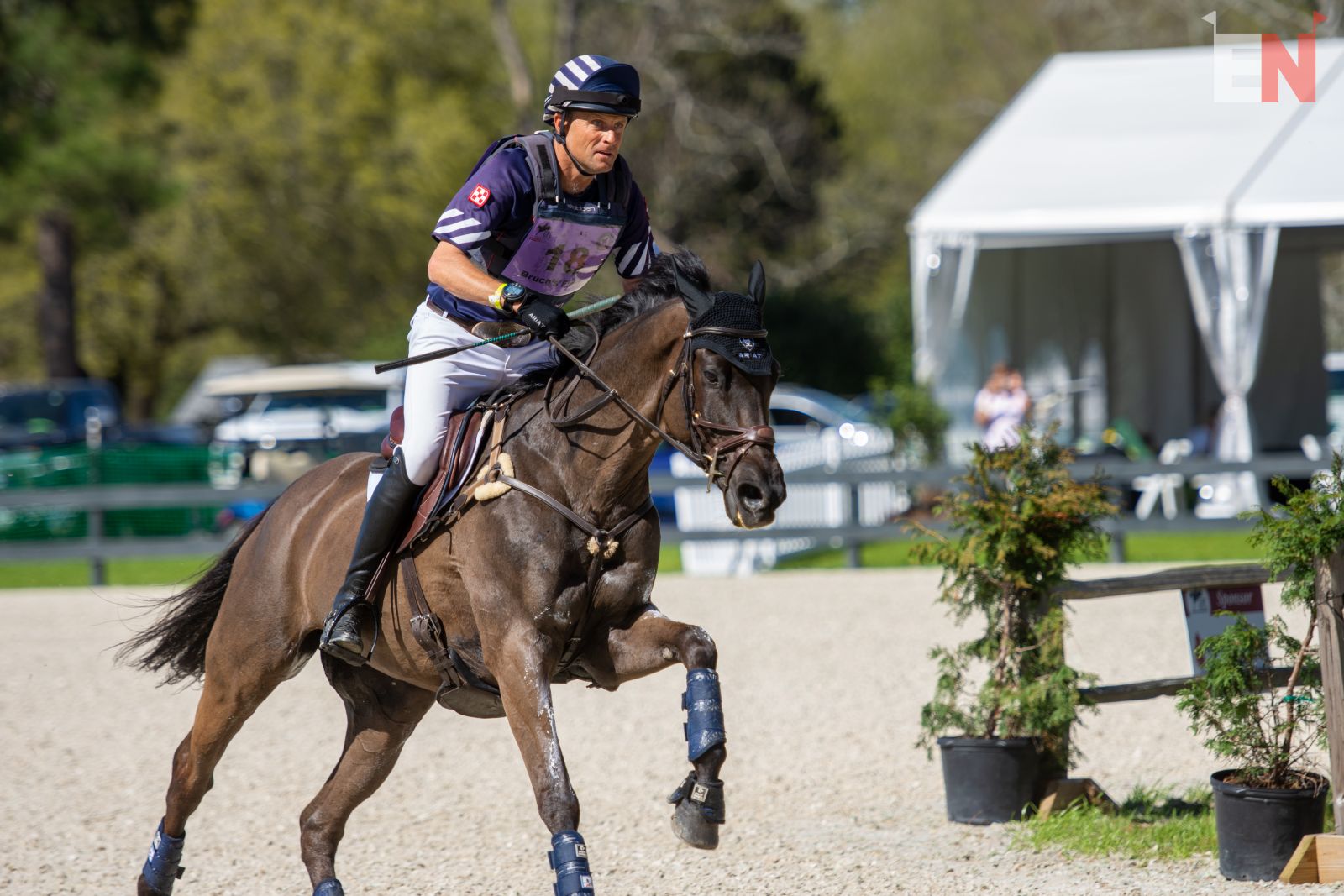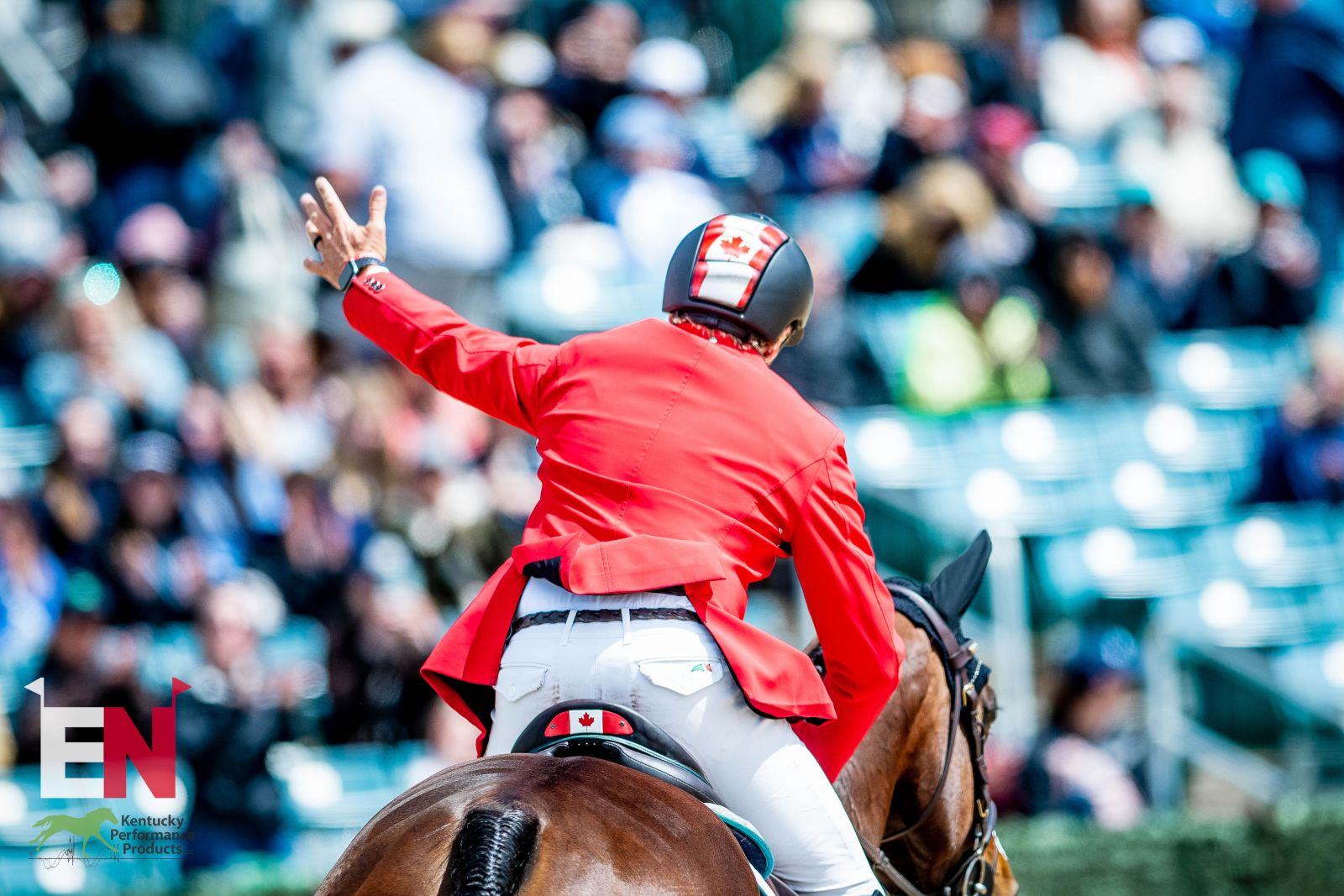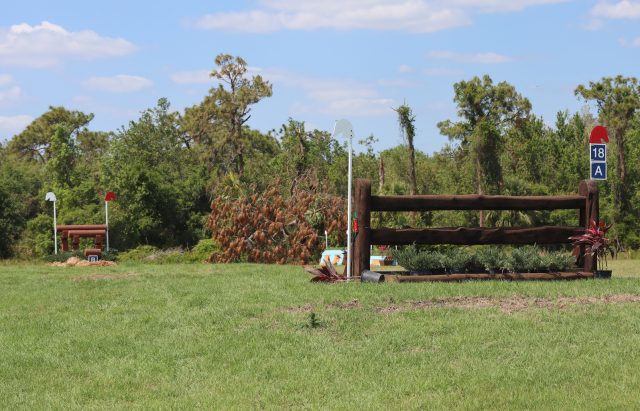Welcome to EN’s 2023 rewind! We’ll be resharing some of our most popular stories from the year throughout the last few days of 2023. This article first appeared on EN in March.
I’ll be honest, when it was suggested that I write a piece about the eventing stallion Mighty Magic (thanks to the recent successes of his offspring at the top levels) I just about fell over.
This is it, folks, the role I was born for.
Finally, my years of being a breeding nerd and a Mighty Magic superfan have paid off, and I can truly say that I’m not sure there’s anyone better suited to tackle this mighty (get it? Sorry not sorry) task.
Before we get started, let me give you my resume:
1) Two of my three horses have Mighty Magic in their pedigree
2) A few years ago I traveled *mumbles incoherently* miles to his current home base in France just so I could see him in person
3) I dutifully stalk every offspring showing worldwide at the FEI levels to keep tabs on their careers, as well as all the ones I can find showing here in the U.S. at the National levels
4) I’m relatively certain Will Faudree might have a restraining order out on me at this point, I just keep showing up at random horse shows to ogle Mason (aka Mama’s Magic Way), who looks so much like my own six-year-old by Mighty Magic that it’s borderline creepy.
Anyway, you get the idea. I am, in my opinion, uniquely qualified for the task of writing about Mighty Magic, and – fair warning – this will most definitely be biased because it’s been penned by his number one fan. You’ve been warned, people. Let us begin.
Mighty Magic (known as “Mighty”) was bred in Germany by Horst-Henning Lienau, a product of several generations of his show jumping breeding program. The elegant bay colt was born in 2003, the second foal of his dam Neika I, a career broodmare who went on to produce over a dozen offspring for Henning. In addition to Mighty, some of her other most notable sport offspring include Akela (by Acorado) who competed to the CCI3* level under British rider Nick Gauntlett, and Chlodowig (by Coriano) who show jumped to the 1.45m level with Philipp Schlaich of Germany.
Mighty’s second dam Fiona VIII, by Lavall was also a member of Hennig’s breeding program. Her most successful sport offspring was Conradin, a 1.60m show jumper by the stallion Contender. This mare line is Holsteiner Stamm (mare family) 1947, which has produced breeding stallions such as Cambridge, Clintord, and Contini, and sport horses such as 1.60m show jumpers Carella 5, Quicka, PMS Candy Girl, Cash and Go, and Cabanza. Mighty’s fourth dam, Peidra, is also the dam of Conejo, a stallion, competed by U.S. rider Karen Cudmore, that show jumped at the 2002 FEI World Equestrian Games and the 2003 FEI World Cup Finals.
The part of Mighty’s pedigree that everyone notices first, though, is the fact that he’s got a full Thoroughbred sire and damsire. His dam, Neika I, is by the famous Thoroughbred stallion Heraldik, one of the most successful sires of event horses of all time.
Born in Czechoslovakia in 1982, Heraldik’s first job was as a steeplechaser, although he wasn’t particularly successful in that endeavor. After a soft tissue injury ended his racing career he became a lesson horse, eventually finding his way to the show jumping ring. There he found his niche, competing up to the 1.50m level with rider Viliam Naštický.
Eventually Heraldik caught the eye of a German breeder, who purchased him for breeding in the hope of adding blood to their mares without sacrificing jumping scope. Heraldik was a success, eventually approved for breeding with at least 10 stud books and is the sire or damsire to over a dozen CCI5* event horses and sire of seven 1.50-1.60m show jumpers.
Mighty’s sire, Mytens, was born and bred right here in the USA. By Kentucky Derby winner Spectacular Bid and out of a Hoist the Flag mare, Mytens was bred by Elmendorf Farm in Kentucky and sold as a yearling at the 1984 Keeneland sale for $950,000.
Although his career as a racehorse didn’t pan out, he was discovered by famous Holsteiner breeder Maas Johannes Hell, who brought the stallion to Germany for use in his sporthorse breeding program. Mytens had a reputation for being a beautiful stallion that passed his elegant type as well as good jumping ability, and he produced multiple showjumpers through the 1.50m to 1.60m levels.
With almost 90% Thoroughbred blood and the rest show jumping blood, you could say that Mighty was certainly born for the sport of eventing. He also looked the part: a moderately tall, elegant, and long-legged colt with a big stride and good uphill gaits.
As we all know, though, it isn’t just what’s on paper that truly matters when it comes to making an event horse –- it’s what’s on the inside that counts. Once again, Mighty proved that he ticked all the boxes.
In 2006 as a three-year-old he completed his 30 Day Stallion Test with a final score of 8.42, with an 8.10 in dressage and 8.38 for jumping, earning high scores for temperament and rideability before moving on to his performance testing.
While his show jumping talent was not considered to be quite up to the high standard of the top show jumping-oriented stallions, given his rideability and natural affinity for the flatwork it was decided to try him as an event horse. Mighty found his way to the stable of German CCI5* rider and Olympic gold medalist Andreas Dibowski (aka Dibo), where they immediately found success in the young horse classes, ending his five-year-old season with Mighty being crowned the German 5-year-old Eventing Reserve Champion.
Even while maintaining a breeding career alongside a show career, Mighty continued to show his aptitude for eventing. According to Dibo, Mighty’s talent for the dressage phase was evident from the start, thanks to his good gaits and workmanlike demeanor. Mighty also took easily to the cross country phase, particularly with his strong gallop, his rideability, and his desire to jump.
While Dibo says that Mighty could be a bit distracted and silly at his home stable, “he was very serious at the competition. He liked to perform and knew when people were watching.” Mighty was often the most reliable of Dibo’s string for the prize giving ceremonies, sometimes ridden by his groom for awards.
With Dibo aboard, Mighty finished second as a six-year-old at the FEI WBFSH Eventing World Breeding Championship for Young Horses at Mondial du Lion in Lion d’Angers, France. As a seven-year-old they came back again, this time winning the 7-Year-Old World Championship title and besting what would become some big-time horses of the future, including FRH Butts Avedon, Quimbo, Paulank Brockagh, and Bay My Hero.
Together Dibo and Mighty competed up through the CCI4* level while also continuing to maintain the stallion’s busy breeding career, thanks to Mighty’s intelligence and generally easy-going nature. Dibo said, “he knew the difference between training and breeding and he was able to do both.”
After the conclusion of his eventing career, Mighty eventually made his way to France to Haras du Feuillard, the breeding and show stable of Valerie and Benoit Burban. There he has continued his stud duties and also served as a dressage mount for their daughter Eugenie, winning Team Bronze at the Children’s European Dressage Championships in Spain when Eugenie was only 13 years old.
As a sire, Mighty got off to a bit of a mixed start in Germany. His first foal crop was born in 2007, and initially some breeders were a bit surprised by his early offspring. Given Mighty’s high blood percentage and elegant type, it was thought that he would refine and lighten his offspring, thus over his first few years at stud he was bred to many mares that were heavier and more old-fashioned in type. Like many stallions, though, Mighty has proven to produce more closely to his damline, and did not lighten those heavy mares the way that many breeders first expected.
Indeed, some of Mighty’s highest-performing offspring have come from mares that had some “blood” themselves. His first foal crop produced CCI4* horse Plenty of Magic, whose dam was by a Selle Francais show jumping stallion and had a French Anglo Arab damsire. CCI4* horse Figaro des Concessions is out of a full French Anglo Arab mare. CCI5* horse Mama’s Magic Way is out of a Hanoverian mare whose sire is the Thoroughbred stallion Star Regent. CCI5* (possibly soon-to-be *knocks on wood* 5- star) horse Miks Master C’s dam is a mix of show jumping and Thoroughbred blood, with a full Thoroughbred fourth dam.
While Mighty has produced a variety of offspring when it comes to type, there are other traits he seems to pass on quite reliably, most notably his big personality and character.
My own Mighty Magic son is a very busy-minded, curious, and playful horse (he has two philosophies: everything goes in his mouth, and life is one big game), so temperament is one of the first things I ask about when I find someone that owns a Mighty offspring. And, conveniently enough, writing this article gave me the perfect excuse to spend hours getting people to tell me all about their own Mighty horses. Under the guise of very serious official EN business, of course. I am always super professional.
Anyway, one of my first victims was the aforementioned Will Faudree. I can’t help it, Mason is my favorite CCI5* horse and I will always start there first. Will and I have compared notes on our horses in the past, sending each other videos of them doing pretty much the same things in the crossties or in the barn. Let’s just say they’re definitely never bored or boring.
Mason was bred in Germany by Mareike Leers-Schreiber of MaMa’s Ausbildungsstall (hence the Mama’s prefix), who produced him through the CCI2* level. He was then spotted by Dibo and moved to his stable, where Mason did a couple events with Dibo in the irons before Will received a fateful phone call.
“I was competing at Fair Hill in 2018 when a friend of mine called me and told me that she had seen a horse at Dibo’s yard that would be a super match for me, but I would have to get there on Monday to try it because if not, it was going to be going to a long format the following weekend,” Will said. “The timing was good and I was able to hop on a plane after show jumping and try him Monday morning, and from the moment I sat on him, I knew he was my horse.”
Mason is known by most eventing fans for being a stunning mover and excellent in the cross country phase, but his journey has not been without its challenges. Will says, “he has been one of the toughest, yet most exciting and fun horses to work with. He has taught me the true definition of patience.”
At times Mason’s exuberance and enthusiasm have gotten the best of him, particularly in the dressage phase. “I often describe him as a three year old little boy at Disney World on a sugar high. So I have had to learn to be that kind of parent. To be honest, I think we are very similar personalities and really good friends.”
Despite sometimes being a bit tricky to ride, there is no doubt that Mason quite enjoys his job; I’m not sure you’ll see any other horse on cross country day that looks as delighted as Mason (who Will hopes to aim for Burghley in the fall). Will says, “When I’m in the warm up for Mason on cross country I’m like a little kid revving the engine.”
Mason also isn’t the first Mighty Magic offspring that Will has produced; he brought Michel 233 (who was out of an old-style Hanoverian mare with only 16% blood) up to the CCI4*L level a few years ago. While Will doesn’t see a lot of similarities between the two horses, personality-wise, he did say that they were both quite fast across the country with a good gallop.
That quality also seems to be present in Miks Master C. “Mickey” was originally produced up the levels by CCI5* rider Maya Black, who says that even as a green youngster he always had a great gallop. While he could be a bit spooky for cross country schooling, Maya says “he was always braver at the competition.”
According to Maya it took a little time for the young gelding to gain his confidence, but as he progressed up the levels he became more and more sure of himself and his character also grew in tandem. Now, he’s described as one of the best horses Liz Halliday-Sharp has ever partnered with, and as his strength and experience grows he stands poised to make his mark on the Land Rover Kentucky Three-Day Event in April. “He’s got a lot of power,” Liz described. “It’s a work in progress. I think when we get it polished in another few months, he’ll be unbelievable.”
Mickey is a U.S.-bred, hailing from the breeding program of one of America’s leading event horse breeders, Laurie Cameron. A self-described hobby breeder for over 30 years, Laurie founded her breeding program in 1991 with a Thoroughbred mare named Bit of Elegance. Early on in Laurie’s breeding venture she spent time in Europe taking breeding courses from the best breeders she could find, learning how they made their stallion and mare matches. There she fell in love with a lot of the Holsteiner show jumping lines, which she thought would be a good match with her hotter Thoroughbred mare.
Laurie has since produced multiple generations of upper-level event horses, including CCI3*L horse Double Diamond C, CCI4*L horse Early Review CBF, as well as Mickey’s dam, CCI2* horse Qui Luma CBF. She has bred mares to Mighty Magic multiple times, with one of those breedings also producing CCI3*S horse Maks Mojo C.
Laurie says that Mickey, along with all her Mighty offspring, has always been a people-oriented horse that enjoys his work, even from a young age. Laurie describes him as the kind of horse who “thinks all of this is just a fun game”. When asked what drew her to choose Mighty Magic for her mares, Laurie said “I always want to breed horses of good type that are rideable, adjustable, safe and want to do their job. Mighty Magic’s love their job.”
Now 20 years old, Mighty is retired to stud duty at Haras du Feuillard in France, where I was able to visit him in 2019. In person he was bigger than I expected, and it was immediately clear where my own Mighty Magic son got his personality –- Mighty strutted out of the stable with a gleam in his eye that said “You’re obviously here to see ME” and made quite the game out of trying to put anything and everything in his mouth. His cheeky temperament and desire to show off was evident, even in his more mature age.
While Mighty isn’t a fit for every mare and his offspring aren’t a fit for every rider, there’s something about the way they approach life that has to be admired. I mean, sure, there’s nothing I own that hasn’t been in my horse’s mouth by now, and sometimes his idea of a fun time is certainly not always the same as mine, but I can say beyond a shadow of a doubt that I have never had a dull moment with that horse.
As more sons and daughters of Mighty climb the ranks I have no doubt that we will see more of them at the upper levels of eventing in the years to come, and I’ll be right there outside the ropes cheering them on. Don’t worry though, I’ll leave the foam fingers and the cowbells at home. Wouldn’t want to spook anyone…



























































































































































